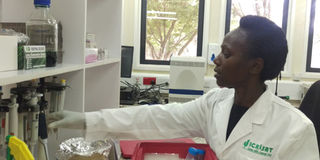System tests and breeds improved crops faster

Dr Damaris Odeny, a Biotechnology Scientist at the International Crops Research Institute for the Semi-Arid Tropics (ICRISAT). Researchers have advanced a new concept of plant breeding named speed breeding to boost the process of developing better crops. FILE PHOTO | NMG
In the search for more resilient crops that produce higher yields, researchers cross one plant with another to introduce desirable traits, wait for the progenies to develop, then test them in the field to see if the desirable traits have been introduced successfully.
This process takes time, continuing from season to season, until the desired traits are achieved, and if testing is done in an open field under rain-fed conditions, it takes a long time to get the improved crop, says Dr Damaris Odeny, a biotechnologist at the International Crop Research Institute for the Semi-arid Tropics (ICRISAT).
To counter this, researchers have developed a new plant breeding system that ensures quick studying and improvement of crop traits hence speeding up the breeding of crops that mature fast and that are more resistant to pests and diseases.
The technique named speed breeding has been advanced by scientists from the John Innes Centre in Norfolk, England and the University of Queensland and University of Sydney, both in Australia.
“There is currently a great challenge in breeding higher-yielding and more resilient crops, hence being able to progress through more crop generations in less time will allow us to quickly produce and test crop gene combinations and find the best arrangements for different environments,” says Dr Brande Wulff, the projects leader of Crop Genetics at John Innes Centre, and who was part of the team that advanced the new method.
Speed breeding uses a greenhouse or any other artificial setting with enhanced lighting to create intense extended days, hence speeding up flowering and development of plants, and ultimately identifying better crops earlier.
Through this system, the research team was able to achieve wheat generations from seed to seed in only eight weeks meaning that it would be possible to grow as many as six wheat generations every year which is more than what can be achieved within the same duration using conventional breeding techniques.
CONTROLLED GROWTH ENVIRONMENTS
This novel advancement also produces plants that are superior and healthier than those grown using the standard conservative settings, hence offering a prospective solution to the prevalent food insecurity in many parts of the world.
While speed breeding fundamentally uses fully controlled growth environments, it can also be adapted to work in traditional greenhouses whereby the less costly and lower heat-emitting light emitting diode (LED) lights are enhanced to boost photosynthesis for up to 22 hours a day.
This extra lighting facilitates faster plant development and uses only one seed per plant to advance each generation.
Speed breeding can be used for a variety of staple food crops such as wheat, barley, a variety of peas, amaranth, rapeseed, sunflower, peanut, pepper, capsicum and radish among other crops, achieving four to six generations of crops per year, which is significantly greater than conventional breeding and cultivating systems.
“In Kenya, for instance, breeding sorghum would take at least two seasons in Western Kenya, meaning two generations, but with speed breeding, the artificial conditions created enhance the development of the crop leading to several crop cycles within a year, and in some cases, attaining even six generations in one year,” notes Dr Odeny.
When employed alongside conventional techniques of facilitating advances in the understanding of the genetic makeup of crops, speed breeding boosts their traits and productivity.
However, while it enhances the selection of hardier crops, speed breeding does not necessarily lead to curbing of pests and diseases directly.



